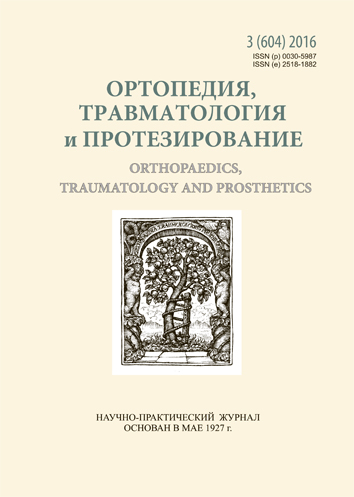Criteria for assessing the effectiveness of arthroscopic access in the treatment of traumatic anterior instability of the shoulder joint
DOI:
https://doi.org/10.15674/0030-59872016361-65Keywords:
evaluation criteria surgical approach, arthroscopy, shoulder jointAbstract
For an objective evaluation of the effectiveness of surgical approach, topographic anatomical criteria are known, which include: the axis of the operating performance, wound depth, angle of surgical performance and operating performance axis tilt, access zone. With the use of technology in arthroscopic treatment of anterior instability of the shoulder joint it was necessary to adapt the proposed concepts in open surgery.
Objective:to evaluate the performance criteria of arthroscopic access to treatment of traumatic anterior instability of the shoulder joint.
Methods: We applied Sozon-Yaroshevich method and criteria for evaluating the effectiveness of surgical approach adapted for endoscopy.
Results: The authors have changed some concepts that are used for evaluation of the wound in the abdominal endoscopic surgery. In particular, the angle of the operating performance, the apex of which is the point of setting the endoscopic port and rays — the direction of the instrument determines the possibility of moving the wound instruments and achieve extreme points of accessibility zones. Important for arthroscopic surgery is the concept of range of motion of the instrument (extreme possible its position within the port), the effective angle of operational steps (between the extreme positions of the tool by which the execution of the necessary manipulations) area accessibility (areas of the bottom of the wound, which can be opened for inspection and manipulation). The concept: an optimal angle of attack, formed a line slope edge instruments and glenoid border when convenient to carry out manipulations to prepare input channel and anchor in articular edge of the blade; the effective accessibility zone (bottom area of the wound where the manipulations performed without restrictions). This scheme calculation of surgical approach.
Conclusions: Arthroscopic method of operation has certain performance standards. Clinical features of pathology determine the different approaches to treatment and improving arthroscopic technique.References
- Sozon-Yaroshevich AYu. Anatomical and clinical substantiation of surgical approaches to the internal organs. Мoskow: Medgiz, 1954. 180 p.
- Burman M. Arthroscopy or the direct visualisation of joint: An experimental cadaver study. Clin. Orthop. Relat. Res. 2001;390:5–9.
- Watanabe M. Takeda S, Ikeuchi H. Atlas of arthroscopy. 3rd ed. Tokyo-New York: Igaku-Shoin, 1978. 174 p.
- Boyle S, Haag M, Limb D, Lafosse L. Shoulder arthroscopy, anatomy and variants. Рart 1. Orthopaedics and Trauma. 2009;23(4):291–6. doi: 10.1016/j.mporth.2009.08.008.
- O’Brien SJ, Allen AA, Coleman SH, Drakos MC. The trans-rotator cuff approach to SLAP lesions: technical aspects for repair and a clinical follow-up of 31 patients at a minimum of 2 years. Arthroscopy. 2002;18:372–7.
- Tischer T, Vogt S, Imhoff AB. Arthroscopic stabilization of the shoulder with suture anchors with special reference to the deep anterior-inferior portal (5.30 o'clock). Oper Orthop Traumatol. 2007;19(2):133–54.
- Wang S, Wang J, Gu C, Zuo J. An anatomic study of glenoid regarding anchor insertion posion and direction. Zhonghua Wai Ke Za Zhi. 2015;53(2):90–4.
- Lim TK, Koh KH, Lee SH, Shon MS, Bae TS, Park WH, Yoo JC. Inferior anchor cortical perforation with arthroscopic Bankart repair: a cadaveric study. Arthroscopy. 2013 Jan;29(1):31-6. doi: 10.1016/j.arthro.2012.08.013.
Downloads
How to Cite
Issue
Section
License
Copyright (c) 2016 Olexiy Tyazhelov, Larisa Goncharova, Roman Pazdnikov

This work is licensed under a Creative Commons Attribution 4.0 International License.
The authors retain the right of authorship of their manuscript and pass the journal the right of the first publication of this article, which automatically become available from the date of publication under the terms of Creative Commons Attribution License, which allows others to freely distribute the published manuscript with mandatory linking to authors of the original research and the first publication of this one in this journal.
Authors have the right to enter into a separate supplemental agreement on the additional non-exclusive distribution of manuscript in the form in which it was published by the journal (i.e. to put work in electronic storage of an institution or publish as a part of the book) while maintaining the reference to the first publication of the manuscript in this journal.
The editorial policy of the journal allows authors and encourages manuscript accommodation online (i.e. in storage of an institution or on the personal websites) as before submission of the manuscript to the editorial office, and during its editorial processing because it contributes to productive scientific discussion and positively affects the efficiency and dynamics of the published manuscript citation (see The Effect of Open Access).














